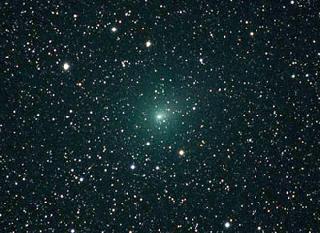
This image of comet Hartley 2 on Oct. 4 in Gainesville, Florida using a 106 mm Takahashi astrograph. Photo: Astronomer Byron Bergert
AUSTIN, TEXAS (BNS): The small comet Hartley 2 will be visible to the unaided eye of sky gazers this week. The comet will make its closest approach to the Sun on October 28.
According to NASA's Jet Propulsion Laboratory (JPL), comet Hartley 2 was 17.7 million kilometers (11 million miles) away from Earth on Wednesday, at 7 pm GMT.
By October 22, the comet will have passed through the constellation Auriga. It will continue its journey across the night sky in the direction of the constellation Gemini.
NASA's EPOXI mission will come within 700 kilometers (435 miles) of Hartley 2 on November 4.
Comet Hartley 2, also known as 103P/Hartley 2, is a relatively small, but very active periodic comet that orbits the sun once every 6.5 years.
From dark, pristine skies in the Northern Hemisphere, the comet should be visible with binoculars as a fuzzy object in the constellation Auriga, passing south of the bright star Capella. Viewing of Hartley 2 from high ambient light locations including urban areas may be more difficult.
EPOXI is an extended mission of the Deep Impact spacecraft. The name EPOXI itself is a combination of the names for the two extended mission components -- the Extrasolar Planet Observation and Characterization (EPOCh) and the Deep Impact Extended Investigation (DIXI).
The spacecraft is closing the distance with the comet at a rate of 976,000 kilometers (607,000 miles) per day. As it gets closer, the rate of closure will increase to a little over 1,000,000 kilometers (620,000 miles) per day.
 Previous Article
Previous Article Next Article
Next Article











The Indian Air Force, in its flight trials evaluation report submitted before the Defence Ministry l..
view articleAn insight into the Medium Multi-Role Combat Aircraft competition...
view articleSky enthusiasts can now spot the International Space Station (ISS) commanded by Indian-American astr..
view article